| Pages:
1
2 |
UnintentionalChaos
International Hazard
    
Posts: 1454
Registered: 9-12-2006
Location: Mars
Member Is Offline
Mood: Nucleophilic
|
|
Crud, I hadn't thought about that. EtBr might be too low boiling to work, though I have quite a bit of that. My supply of iodides is limited.
Do you think that this procedure could be modified for ethyl iodide? I don't really see why not, to be honest. http://www.sciencemadness.org/talk/viewthread.php?tid=12475
I have prepared some MeI with it, and got 70% yield, but I think I know where I lost the 10%.
Department of Redundancy Department - Now with paperwork!
'In organic synthesis, we call decomposition products "crap", however this is not a IUPAC approved nomenclature.' -Nicodem
|
|
|
Magpie
lab constructor
    
Posts: 5939
Registered: 1-11-2003
Location: USA
Member Is Offline
Mood: Chemistry: the subtle science.
|
|
That's a good question. I would like to make this a general discussion so will take it up in the existing "Ethyl Iodide" thread:
http://www.sciencemadness.org/talk/viewthread.php?tid=2727&a...
The single most important condition for a successful synthesis is good mixing - Nicodem
|
|
|
Magpie
lab constructor
    
Posts: 5939
Registered: 1-11-2003
Location: USA
Member Is Offline
Mood: Chemistry: the subtle science.
|
|
I recrystallized the 24.5g of crude 2-naphthol using 33v/v% Ace denatured alcohol. There was some oil-out but not much. This was discarded. The
crystals were caught on a Buchner funnel then dried overnight at room temperature. The melting point was 121°C vs the lit value of 122°C. The
recovered yield was 17.8g. This is a 56.8% yield based on the 50g of Na 2-naphthalene sulfonate charged.
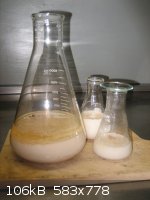
The single most important condition for a successful synthesis is good mixing - Nicodem
|
|
|
Nicodem
Super Moderator
      
Posts: 4230
Registered: 28-12-2004
Member Is Offline
Mood: No Mood
|
|
Alkylation of naphthols with ethyl bromide should work just fine. Ethyl bromide is quite reactive and 24-48 h at 50 °C in acetone with
K2CO3 as the base is usually good enough for this reagent. Alternatively, for alkylations of phenols with alkyl bromides, KOH
or NaOH in ethanol often works even better.
…there is a human touch of the cultist “believer” in every theorist that he must struggle against as being
unworthy of the scientist. Some of the greatest men of science have publicly repudiated a theory which earlier they hotly defended. In this lies their
scientific temper, not in the scientific defense of the theory. - Weston La Barre (Ghost Dance, 1972)
Read the The ScienceMadness Guidelines!
|
|
|
Magpie
lab constructor
    
Posts: 5939
Registered: 1-11-2003
Location: USA
Member Is Offline
Mood: Chemistry: the subtle science.
|
|
Quote: Originally posted by Nicodem  |
Alkylation of naphthols with ethyl bromide should work just fine. Ethyl bromide is quite reactive and 24-48 h at 50 °C in acetone with
K2CO3 as the base is usually good enough for this reagent. Alternatively, for alkylations of phenols with alkyl bromides, KOH
or NaOH in ethanol often works even better. |
For comparison, my college handout recipe specifies the use of ethyl iodide in methanol, and KOH. Reflux time is 1.5-2 h.
The single most important condition for a successful synthesis is good mixing - Nicodem
|
|
|
Nicodem
Super Moderator
      
Posts: 4230
Registered: 28-12-2004
Member Is Offline
Mood: No Mood
|
|
As alternatives to ethyl halides/sulfates/sulfonates/etc., there are several reports that nerolin can be prepared by heating 2-naphthol and ethanol in
the presence of various acid catalysts (NaHSO4, H2SO4, FeCl3, CuCl2, Al2(SO4)3, and so on). Unfortunately most of these publications are in Chinese
and in some difficult to get journals. There are some older and easily accessible references, for example:
Ber. 1882, 15, 1427 (probably the first report on this reaction)
J. Am. Chem. Soc. 1935, 57, 1459–1464. DOI: 10.1021/ja01311a025
J. Chem. Soc. 1900, 77, 33.
It was proposed the reaction proceeds trough the hemiacetalysation of the keto tautomer of naphthols, followed by the rearomatization by water
elimination. If so, and experiments indicate this, it is only useful for 2-naphthols and higher benzophenols where the tautomerization is possible at
all.
An interesting article describes that refluxing 2-naphthol in ethyl acetate in the presence of catalytic amounts of sulfuric acid for 4 h gives
nerolin in 40-45% yields. The mechanism is probably similar. See J. Am. Chem. Soc. 1952, 74, 6118. DOI: 10.1021/ja01143a516
…there is a human touch of the cultist “believer” in every theorist that he must struggle against as being
unworthy of the scientist. Some of the greatest men of science have publicly repudiated a theory which earlier they hotly defended. In this lies their
scientific temper, not in the scientific defense of the theory. - Weston La Barre (Ghost Dance, 1972)
Read the The ScienceMadness Guidelines!
|
|
|
nezza
Hazard to Others
  
Posts: 324
Registered: 17-4-2011
Location: UK
Member Is Offline
Mood: phosphorescent
|
|
 Thanks for the post benzylchloride. I have not been able to get hold of
naphthol so I had a go at your synthetic route. It worked perfectly. I have a beige coloured product which gives the expected red dye with diazotised
sulfanilic acid. I used a low temperature sulfonation so my product is mainly 1-naphthol. Thanks for the post benzylchloride. I have not been able to get hold of
naphthol so I had a go at your synthetic route. It worked perfectly. I have a beige coloured product which gives the expected red dye with diazotised
sulfanilic acid. I used a low temperature sulfonation so my product is mainly 1-naphthol.
|
|
|
smaerd
International Hazard
    
Posts: 1262
Registered: 23-1-2010
Member Is Offline
Mood: hmm...
|
|
Another method could be nitration, reduction, and hydrolysis?
Probably don't need to go this route for the nitration but I found it reading about other transformations and thought it was neat.
Title: Silica Gel-Mediated Organic Reactions under Organic Solvent-Free Conditions
Authors: Satoaki Onitsuka, Yong Zhi Jin, Ajam C. Shaikh, Hiroshi Furuno and Junji Inanaga
Molecules 2012, 17, 11469-11483
doi:10.3390/molecules171011469
As for the hydrolysis I guess the information is in this collection
Title: Naphthalene Derivatives
Author: Gerald Booth
DOI: 10.1002/14356007.a17_009
http://onlinelibrary.wiley.com/doi/10.1002/14356007.a17_009/...
I don't have access so I can't really tell if it's viable or not.
|
|
|
DJF90
International Hazard
    
Posts: 2266
Registered: 15-12-2007
Location: At the bench
Member Is Offline
Mood: No Mood
|
|
The problem with going via the amines is that its difficult to get regiopure nitronaphthalene and the 2-naphthylamine is a potent carcinogen
(carinogenity of the 1-naphthylamine was attributed to the presence of small amounts of the 2-isomer). If this is a route you intend on taking please
ensure you're equipped to work with such materials.
|
|
|
White Yeti
National Hazard
   
Posts: 816
Registered: 20-7-2011
Location: Asperger's spectrum
Member Is Offline
Mood: delocalized
|
|
I'm interested in making the 2-isomer of tetralone. I found one synthesis that started from a 2-naphthol-ethyl ether, but this synthesis called for
sodium to reduce the second aromatic ring, and that's simply not up my alley.
I was wondering if one could potentially start from tetralin and oxidize the positions along the non-aromatic ring to give a mixture of 1-tetralinol
and 2-tetralinol. The alcohol can then be reduced to a ketone with hypochlorite relatively easily.
Is there an oxidation reaction that will effect oxidation upon a non-aromatic ring while leaving the aromatic ring untouched?
"Ja, Kalzium, das ist alles!" -Otto Loewi
|
|
|
Magpie
lab constructor
    
Posts: 5939
Registered: 1-11-2003
Location: USA
Member Is Offline
Mood: Chemistry: the subtle science.
|
|
I recently made 7.7g of 1-naphthol from naphthalene (Enoz "old-fashioned" mothballs). Not finding a procedure in the literature I used that by
benzylchloride1 in this thread for the precursor Na 1-naphthalene sulfonate and that in Vogel for 2-naphthol to make the 1-napthol.
Making the Na 1-naphthalene sulfonate using con sulfuric acid at 55°C was uneventful. 50g of naphthalene was charged to a 3-neck 1000mL RBF
w/mechanical stirring. I would use a 500mL RBF next time. I used a silicone oil bath controlled to 57°C with a PID controller. % yield was 50.9%.
The precursor was fused to 1-napthol using KOH per the procedure in Vogel's for 2-naphthol. There was a lot of spitting of the molten reactants and
my temperature/time was a little out of control. I have some remedies for this situation for my next fusion: 1) a 1" deeper all-copper crucible,
and 2) a Bi/Sn eutectic heat transfer fluid for the thermometer-stirrer. The first crystallization gave 16.1g of crude 1-naphthol (mp = 75-87°C vs
lit value of 96°C). Then followed several batches of recrystallizations in 33v/v% solvent grade alcohol, none of which gave good melting points, ie,
90-92°C, 88-90°C, and 76-80°C. There was also significant oil-out. The oil was distilled at atmospheric pressure at 278°C. Upon taking a
melting point of the solidified distillate it was 86-88°C. Altogether my yield was just a hard-won 7.7g for a % yield of 25.1%. Next time I would
distill the whole batch to avoid the recrystallizations/oil-out scenario. It is interesting to note that 1-naphthol has a strong phenol smell. I
don't remember my 2-naphthol having much of a smell.
Comments, recommendations, or questions?
[Edited on 13-3-2013 by Magpie]
[Edited on 14-3-2013 by Magpie]
The single most important condition for a successful synthesis is good mixing - Nicodem
|
|
|
Blue Matter
Hazard to Others
  
Posts: 107
Registered: 20-6-2013
Location: US
Member Is Offline
Mood: Optimus
|
|
Synthesis of sodium 1-naphthalene sulfonate
These are some pictures I took during the synthesis of sodium 1-naphthalene sulfonate, I know that this thread has been inactive for a while but
figured someone might be interested in the pictures I took while making the sulfonate.
The pictures should be in order
The first picture was Sulfuric acid and naphthalene reacting in a 3 neck 250ml flask with overhead stirrer and water bath.
Second picture is the solution of water and product from he first picture.
third and fourth picture is Sodium bicarbonate being added into the flask.
fifth picture is the solution after boiling and adding sodium chloride leaving it in ice bath to crystallize.
The sixth and seventh pictures are the final product after around a hour in a ice bath.
I hope you found these pictures interesting, I will be attempting synthesis of 2-napthol soon and will have pictures of it also.
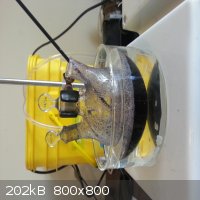 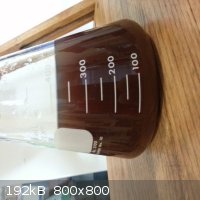 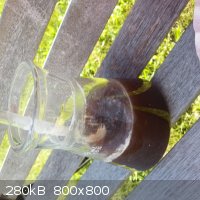 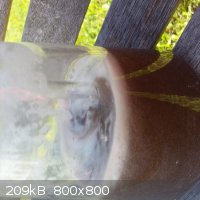 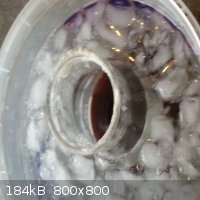 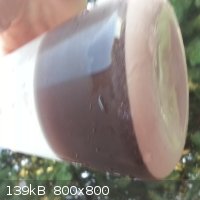 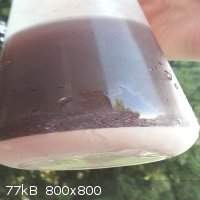
|
|
|
hyfalcon
International Hazard
    
Posts: 1003
Registered: 29-3-2012
Member Is Offline
Mood: No Mood
|
|
You chasing a synthesis on Tetralin, Blue?
|
|
|
Blue Matter
Hazard to Others
  
Posts: 107
Registered: 20-6-2013
Location: US
Member Is Offline
Mood: Optimus
|
|
Actually Parared dye, 2-napthol is one of the ingredients in synthesizing it.
Tetralin sound interesting thought I will look into it.
|
|
|
bob800
Hazard to Others
  
Posts: 240
Registered: 28-7-2010
Member Is Offline
Mood: No Mood
|
|
Why am I getting so much (grey) precipitate (and no crystals)?
I used the procedure by Fieser for sodium 2-naphthalene sulfonate:
| Quote: |
For this sulfonation at an elevated temperature it is convenient to use a 200-cc. three-necked round-bottomed flask. This is supported in a position
convenient for heating with a free flame and a mechanically driven stirrer is fitted into the middle open- ing, the shaft turning in a bearing
consisting of a glass tube inserted in a cork stopper of suitable size. The bearing may be lubricated with glycerol. The best form of stirrer is a
glass rod bent through an angle of 45 0 about 2 cm. from the end. A ther- mometer is inserted with a cork in one of the side tubulatures in such a way
that the bulb will be immersed when the flask is one-third filled. The sulfuric acid is to be run in from a dropping funnel which should be clamped in
such a position that it will deliver into the third tubulature of the flask.
In the flask melt 50 g. of naphthalene, start the stirrer, and adjust the flame until a steady temperature of 160° is maintained. In the course of 3
minutes run in from the dropping funnel 45 cc. of c.p. concentrated sulfuric acid, keeping the temperature at 160° (the flame may be removed). After
stirring for 3 minutes longer pour the solution into 400 cc. of water. In a well con- ducted operation there will be no precipitate of naphthalene,
but there may be 1-2 g. of the water-insoluble di-^-naphthyl sulfone, formed thus: C10H7SO3H -\- CIOHS ^- C10H7SO2C10H7 -f" H2O To remove it boil the
solution with animal charcoal and filter by suction.
Partially neutralize the clarified solution by adding cautiously 20 g. of sodium bicarbonate in small portions. Saturate the solution at the boiling
point by adding sodium chloride (30-35 g.) until crystals persist in the hot solution, and then allow crystallization to take place. Recrystallize the
material, using this time only a small amount of sodium chloride. Test the purity of the product by examining a sample of the />-toluidine salt
which, when pure, melts at 217-218 0 . (See page 140.) The yield is 70-75 g. |
Only 48.84g of naphthalene made it in my flask (after powdering moth balls), but I thought that would be fine as I was using Rooto drain opener which
certainly contained some water.
Initially, the naphthalene was melted in a 250 mL round bottom flask; however, I was unable to get the temperature hot enough with this setup (using a
free flame). I let the flask cool, then some time later remelted the naphthalene and transferred it to a 250 mL Erlenmeyer, which I then heated
directly on my hotplate.
Somehow I misread my thermometer and began adding the H2SO4 at 180*C instead of 160*, though I soon realized this and lowered the temperature to
~160*C. The mixture turned dark purple and quickly black. Magnetic stirring was begun and the acid dripped in for roughly 3-4 minutes with somewhat
poor temperature control (but maintained within +/- 10*). After complete addition of the acid, the mixture was allowed to stir for an additional 3
minutes.
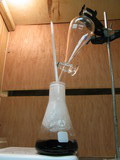
The mixture was poured into 400 mL RT water, with the formation of a greyish precipitate in black solution. The solution was boilied with a generous
heaping of activated charcoal and vacuum filtered to yield a clear, very very very dark purple solution.
20g of NaHCO3 were added with stirring, causing the formation of a creamy layer1 on top of the solution. Most of this dissolved with
stirring, but the solution was gravity filtered just in case.
Next the solution (IIRC there it was 350 mL in volume) was boiled and saturated with 24.3g NaCl. The solution was allowed to cool with the formation
of a precipiate:
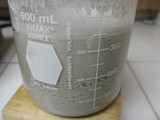
The grey precipiate was vacuum filtered/dried for about 20-30 minutes. It weighed 137.82g at this point, which I do not understand... the estimated
yield was 70-75g, and there could only be a maximum of 24.3g NaCl mixed in, along with residual water, though I have a hard time believing that there
was at least 50.7g of water in there.
Anyway I thought the recrystallization step might "fix" things so I dissolved the precipiate in 400 mL of boiling 10% NaCl solution. Shortly after I
set it down (5 min?), however, a huge mass of similar-looking grey precipiate formed!
I haven't massed it yet but I'm sure it's way over 70g... and still quite dull and grey
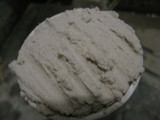
The solution remained quite acidic after the NaHCO3 was added so I don't think there is any excess precipitating out...
1Interestingly enough this was bright-white unlike the my main yield...
--Also, I used Kosher Salt for my sodium chloride.
Any suggestions would be greatly appreciated!
[Edited on 9-8-2013 by bob800]
[Edited on 9-8-2013 by bob800]
|
|
|
Blue Matter
Hazard to Others
  
Posts: 107
Registered: 20-6-2013
Location: US
Member Is Offline
Mood: Optimus
|
|
When I made it there was a lot of residual moisture even after filtration and it looked like much more than it actually was, once it was totally dry I
ended up with 67g. I don't think that it would be a big problem but maybe try using a different brand of drain cleaner or pure H2SO4. The really white
crystals are made from really pure chemicals I feel like any contaminants will change the color?
Also see what your density is g/cm
|
|
|
UnintentionalChaos
International Hazard
    
Posts: 1454
Registered: 9-12-2006
Location: Mars
Member Is Offline
Mood: Nucleophilic
|
|
I too, did the preparation of 2-naphthol from naphthalene and sulfuric acid, followed by alkali fusion per Vogel 3rd edition. I don't have much to
add, and my yields were pretty in-line with others in this thread. During the prep of the sodium 2-naphthalenesulfonate, you can squeeze a few extra
grams of product out of the recrystallization liquor after filtering off the first crop by adding 15 more grams of NaCl per 100ml of filtrate, heating
up to dissolve everything, and allowing to cool undisturbed.
I started out with 50g of naphthalene and got 52.98g of sodium naphthalenesulfonate after the first recrystallization. The second crop gained by
adding additional NaCl weighed 7.64g for a total of 60.62g.
For the fusion DO NOT add any water. Instead of 120g KOH, use 60g of KOH and 40g of NaOH prills with no added water. This is a
roughly equimolar mixture that forms a low melting eutectic. I found that my melt spit very little, though I would still advise some sort of heat
resistant gloves and probably a lab jacket. I think the problem is that as hydroxide is consumed in reaction and turned into sulfite, the capacity to
hold onto superheated water vanishes and it suddenly turns into steam. It is absurdly hard to dry KOH and it clings to water in surprising amounts
even when molten, including what you added deliberately. I had only what few % of water came in the technical KOH.
Department of Redundancy Department - Now with paperwork!
'In organic synthesis, we call decomposition products "crap", however this is not a IUPAC approved nomenclature.' -Nicodem
|
|
|
Zephyr
Hazard to Others
  
Posts: 341
Registered: 30-8-2013
Location: Seattle, WA
Member Is Offline
|
|
I preformed a procedure fro vogels, that is very similar to the one done by bob800. After recrystallization, i too was left with this grayish gunk. I
may have gone slightly over the recomended tempature, but otherwise the experiment went perfect. Any idea what this goop is?
<img src="https://sites.google.com/site/g1rafcultchemistrypictures/pis/IMG_4041.JPG" width="800" />
<!-- bfesser_edit_tag -->[<a href="u2u.php?action=send&username=bfesser">bfesser</a>: reduced
image size(s)]
[Edited on 11.2.14 by bfesser]
|
|
|
Mailinmypocket
International Hazard
    
Posts: 1351
Registered: 12-5-2011
Member Is Offline
Mood: No Mood
|
|
Mine looked just like that (except pinkish because I didn't bother to recrystallize and some of the dye from the acid must have made it through). It
proved quite annoying to dry this stuff well though.
|
|
|
benzylchloride1
Hazard to Others
  
Posts: 299
Registered: 16-3-2007
Member Is Offline
Mood: Pushing the envelope of synthetic chemistry in one's basement
|
|
The sulfonate salt tenaciously hangs on to water, it is often advisable to dissolve in boiling water and add finely ground NaCl, slowly until the
product begins to crystallize and then slowly cool to room temperature. The product is a pain to dry, I would press the filter cake under vacuum and
allow all the water to drain out, probably about 30 minutes. I would then dry in a warm place in a glass dish for several days after breaking the
material up. Remove the filter paper before this final drying. Be patient, it can take longer then a week if the drying vessel it not gently heated,
50 to 60 C.
Amateur NMR spectroscopist
|
|
|
BOD513
Harmless

Posts: 10
Registered: 15-2-2016
Member Is Offline
Mood: No Mood
|
|
I know this thread has been inactive for a while, but I'm experiencing something weird running the sulfonation reaction and I wonder if anyone has had
the same thing- the reaction starts off in the usual way, with the light pink/purple slowly giving way to a dark purple/black solution, but at some
point a couple hours in, the reaction mixture solidifies as a blueish grey concrete-like mass. This is strange because it happens extremely rapidly;
from the time it begins thickening to the time it hardens completely is usually less than five seconds. This not only results in no yield, but is a
real pain to clean out of glassware. I've been using enoz moth flakes that claim to be 99%+ naphthalene, but I'm wondering if this might be false. I
haven't found anything in the literature that would indicate what could be happening here (there doesn't seem to be much out there in general about
synthesizing the 1-naphthalene sulfonate salt), has anyone had this happen to them?
Edit: On further examination I've found what may be the strangest part of this- it only happens when being stirred. When I've used a thermometer (the
first attempt) or a jury-rigged mechanical stirrer (the second and third attempts) it solidifies. When I covered the beaker with Saran Wrap and just
left it in the sun all day, the reaction proceeded pretty much as it did for previous people in this thread, albeit with a low yield. Strange
[Edited on 18-6-2016 by BOD513]
[Edited on 18-6-2016 by BOD513]
|
|
|
| Pages:
1
2 |